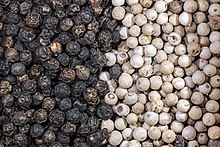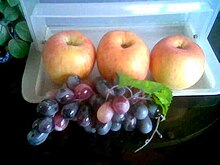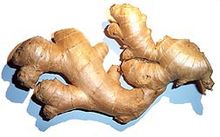Bioenhancer
Bioenhancers are substances that increase the availability of active ingredients, vitamins and nutrients to their target structures ( bioavailability ). The term “bioenhancer” was coined at the Indian Institute of Integrative Medicine in Jammu , the underlying concept has its roots in Ayurvedic medicine . It is hoped that the targeted administration of naturally occurring bioenhancers will increase the effectiveness of medicinal substances and nutraceuticals . So far, bioenhancers have been discovered almost exclusively in plants.
discovery
In 1929 Kartick Chandra Bose reported that the anti-asthmatic effects of Indian lungwort were enhanced by the simultaneous ingestion of long pepper . In 1979 piperine, which occurs in pepper, was described as the first "bioavailability enhancer".
Mechanisms of Action
The following mechanisms are postulated for improving the bioavailability of substances by bioenhancers:
- Increase in the absorption of substances in the intestine
- Inhibition of the breakdown of substances in the intestines and in the liver
- Increasing the permeability of pathogens to active substances
- Inhibition of the defense mechanisms of pathogens or tumor tissue (e.g. efflux of the active ingredients)
- Improvement of the binding possibilities for active substances at the binding sites (such as DNA and proteins) of a pathogen
- Improving the crossability of the blood-brain barrier
- Reduction / avoidance of the first pass effect
Examples of bioenhancers
The following examples of bioenhancers provide an insight into pharmacological research and show how ingredients from pepper, curry, ginger and other plant-based ingredients in food can prevent nutrient deficiencies or can interact with medicinal substances.
Piperine , an ingredient in pepper, has been shown to act as a bioenhancer for vitamins (A, B 1 , B 2 , B 6 , C, D, E, K), amino acids (lysine ), partly in vitro , partly in animal experiments or in humans , Isoleucine, leucine, threonine, valine, tryptophan, phenylalanine and methionine), minerals (iodine, calcium, iron, zinc, copper, selenium, magnesium, potassium, manganese), vegetable compounds (including ginsenosides, pycnogenol), as well as synthetic and vegetable ones Active ingredients (including ibuprofen , diclofenac , rifampicin , ampicillin , tetracycline , vasicin , pyrazinamide, fexofenadine , resveratrol , epigallocatechin gallate , curcumin ). The effect is based on mechanisms such as promoting absorption in the intestine by activating γ-glutamyl transpeptidase and enzyme inhibition: for example, inhibition of aryl hydrocarbon hydroxylase (AHH), ethylmorphine-N-demethylase, UDP-glucuronyltransferase (UGT), P-glycoprotein and CYP3A4 . The last two enzymes mentioned above in particular contribute significantly to the first-pass effect .
Curcumin, which occurs in turmeric , among other things , like piperine, inhibits the enzyme CYP3A4 and influences the transport function of the P-glycoprotein . Combined with curcumin, an increased bioavailability of the active ingredients celiprolol and midazolam was demonstrated in animal experiments .
Quercetin , a flavonoid made from the fruits and leaves of various plants, has a similar effect to curcumin and piperine. In animal experiments, quercetin increased the bioavailability of the cytostatically active drug paclitaxel .
Due to the gingerols it contains, ginger promotes the absorption of numerous compounds in the intestine, including medicinal substances. In most cases, ginger works synergistically with piperine.
Glycyrrhizin , a saponin from the liquorice plant , increases the activity of numerous antibiotics and the fungicide clotrimazole .
The allicin contained in garlic enhances the effect of the fungicide amphotericin B on yeast cells by acting on the intracellular transport of ergosterol .
Practical use
The discovery and characterization of bioenhancers has resulted in several patent applications. In its function as a bioenhancer, piperine is marketed in various dietary supplements, either alone or in combination with other substances such as vitamins , curcumin , resveratrol or ubiquinone-10 . The preparation Risorine against tuberculosis has been approved in India since 2009 . In addition to the antibiotics rifampicin and isoniazid , the drug contains piperine, which has reduced the rifampicin dose to less than half that of conventional formulations.
In the European countries or the USA piperine has no meaning as a medicinal substance. In modern drug development, oral bioavailability is improved or controlled through measures such as changing the polarity of molecules through chemical modifications (generating prodrugs ), micronization of the active ingredient, use of polymorphic forms and various forms of controlled drug delivery and drug targeting .
source
- Ghanshyam B. Dudhatra et al: A Comprehensive Review on Pharmacotherapeutics of Herbal Bioenhancers . In: The Scientific World Journal. January 2012, pp. 1–33.
Individual evidence
- ↑ KC Bose: Pharmacopoeia India. Bose Laboratories, Calcutta 1929.
- ↑ CK Atal: A breakthrough in drug bioavailability-a clue from age old wisdom of Ayurveda. In: IMDA Bulletin. Volume 10, 1979, pp. 483-484.
- ^ N. Atal, KL Bedi: Bioenhancers: revolutionary concept to market. In: J. Ayurveda & Integrative Med. 2, 2010, pp. 96-99. PMC 3151395 (free full text).




